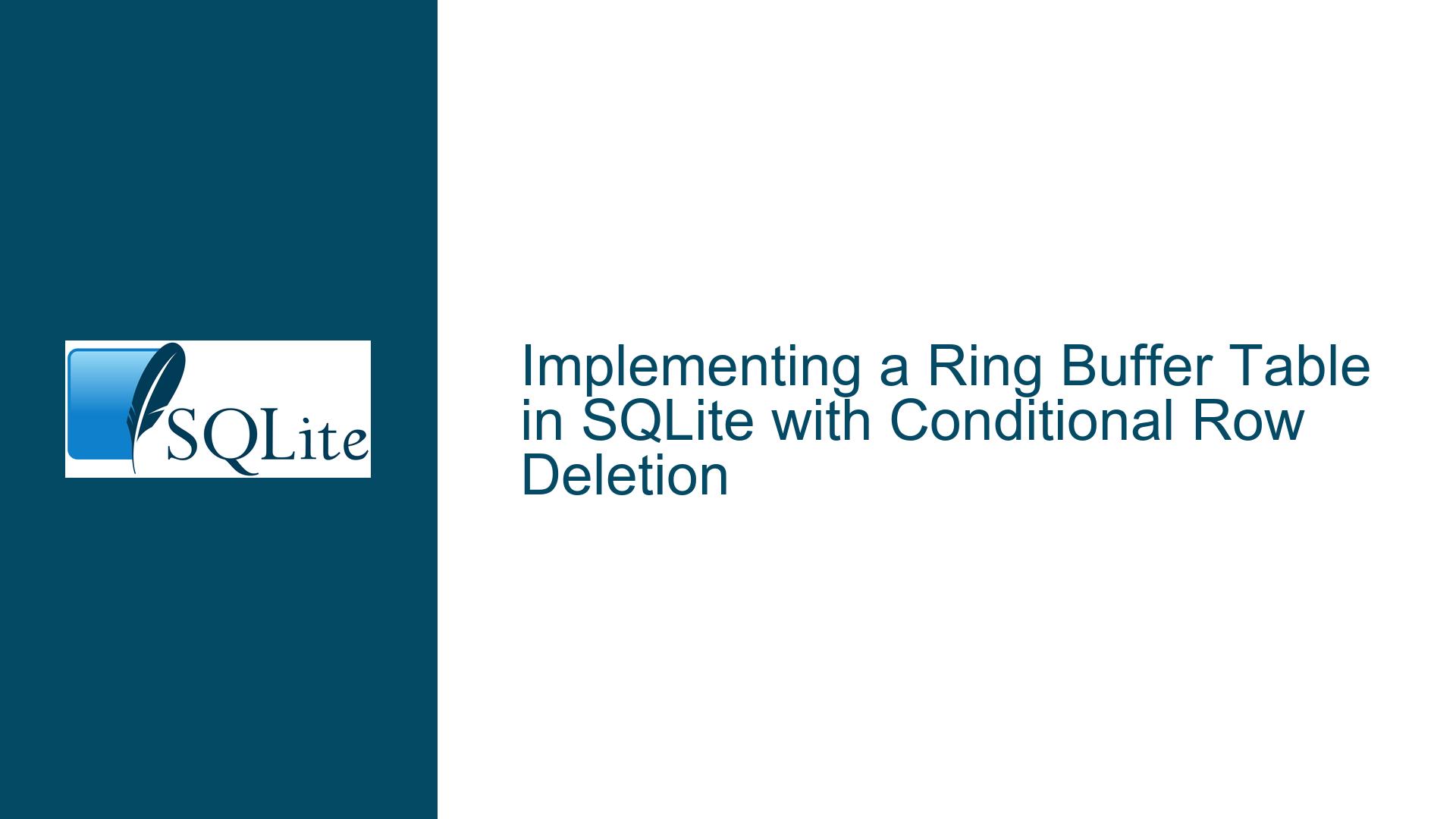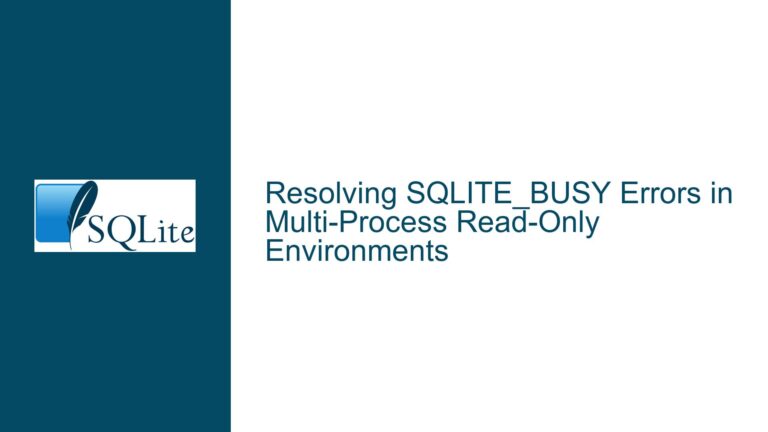Implementing a Ring Buffer Table in SQLite with Conditional Row Deletion
Ring Buffer Table Requirements and Challenges
Implementing a ring buffer in SQLite involves creating a table that automatically deletes the oldest row when a maximum row count is reached. However, the definition of the "oldest row" is not straightforward. The oldest row is determined by a set of conditions:
- A row is not the oldest if it is the last row of all rows with the same
GroupID. - A row is not the oldest if its
Ackcolumn is set to 1. - The oldest row is the one with the lowest
IDamong the candidates that satisfy the above conditions. - Only one row should be deleted when the table reaches its maximum size.
For example, consider the following table:
| ID | GroupID | Ack |
|---|---|---|
| 1 | 100 | 0 |
| 2 | 200 | 1 |
| 3 | 200 | 0 |
| 4 | 300 | 0 |
| 5 | 300 | 0 |
| 6 | 200 | 0 |
| 7 | 200 | 0 |
In this case, the row with ID = 3 is the oldest row and should be deleted when the table reaches its maximum size. The challenge lies in implementing this logic efficiently, especially when dealing with large datasets.
Performance Bottlenecks and Logical Complexities
The primary performance bottleneck in implementing a ring buffer table in SQLite arises from the need to frequently evaluate complex conditions to determine the oldest row. The conditions involve:
- Checking if a row is the last row in its group.
- Ensuring that rows with
Ack = 1are not considered for deletion. - Identifying the row with the lowest
IDamong the eligible candidates.
These conditions require multiple subqueries and joins, which can be computationally expensive, especially when the table contains thousands of rows. Additionally, the use of operations like EXCEPT and GROUP BY can further slow down the process, as they require scanning large portions of the table.
Another complexity arises from the need to maintain consistency when inserting new rows. The trigger that handles the deletion of the oldest row must execute before the new row is inserted. This means that the trigger must quickly identify and delete the oldest row without causing significant delays in the insertion process.
Optimized Trigger Implementation and Indexing Strategies
To address these challenges, we can implement an optimized trigger that efficiently identifies and deletes the oldest row while minimizing the computational overhead. The key to this optimization lies in the use of appropriate indexes and the elimination of redundant subqueries.
Table and Index Definitions
First, we define the table and the necessary indexes:
CREATE TABLE t (
ID INTEGER PRIMARY KEY,
GroupID INTEGER NOT NULL,
Ack INTEGER NOT NULL CHECK (Ack IN (0, 1))
WITHOUT ROWID;
CREATE UNIQUE INDEX t_Deleteable_ID ON t (ID, GroupID) WHERE Ack != 1;
CREATE INDEX t_GroupID ON t (GroupID, ID, Ack);
The t_Deleteable_ID index includes only rows where Ack != 1, which allows us to quickly filter out rows that should not be considered for deletion. The t_GroupID index is used to efficiently query rows by GroupID and ID, which is essential for determining the last row in each group.
Optimized Trigger Implementation
Next, we implement the trigger that handles the deletion of the oldest row:
CREATE TRIGGER t_bi_prune BEFORE INSERT ON t
BEGIN
DELETE FROM t
WHERE ID = (
SELECT ID
FROM t AS o
WHERE EXISTS (
SELECT 1
FROM t
WHERE GroupID = o.GroupID AND ID > o.ID
)
AND Ack != 1
ORDER BY ID
LIMIT 1
)
AND (SELECT COUNT(ID) FROM t) >= 6;
END;
This trigger works as follows:
- The
EXISTSsubquery checks if there is another row in the same group with a higherID. This ensures that the row being considered is not the last row in its group. - The
Ack != 1condition ensures that rows withAck = 1are not considered for deletion. - The
ORDER BY IDandLIMIT 1clauses ensure that the row with the lowestIDamong the eligible candidates is selected for deletion. - The
(SELECT COUNT(ID) FROM t) >= 6condition ensures that the deletion only occurs when the table has reached its maximum size.
Performance Considerations
The optimized trigger significantly reduces the computational overhead by:
- Using the
EXISTSclause instead ofEXCEPT, which eliminates the need to process the entire result set before applying theLIMIT 1clause. - Leveraging the
t_Deleteable_IDindex to quickly filter out rows that should not be considered for deletion. - Using the
t_GroupIDindex to efficiently query rows byGroupIDandID.
Additional Performance Improvements
For further performance improvements, we can introduce additional tables to keep track of the row counts and group counts:
CREATE TABLE t_group_count (
GroupID INTEGER NOT NULL PRIMARY KEY,
Count INTEGER NOT NULL
) WITHOUT ROWID;
CREATE TABLE t_count (
Rows INTEGER NOT NULL DEFAULT 1
);
INSERT INTO t_count VALUES (0);
CREATE TRIGGER t_insert_count AFTER INSERT ON t
BEGIN
INSERT INTO t_group_count (GroupID, Count)
VALUES (NEW.GroupID, 1)
ON CONFLICT (GroupID) DO UPDATE SET Count = Count + 1;
UPDATE t_count SET Rows = Rows + 1;
END;
CREATE TRIGGER t_delete_count AFTER DELETE ON t
BEGIN
UPDATE t_group_count SET Count = Count - 1 WHERE GroupID = OLD.GroupID;
UPDATE t_count SET Rows = Rows - 1;
END;
These additional tables and triggers allow us to maintain the row counts and group counts without having to perform expensive COUNT operations on the main table. The t_bi_prune trigger can then be modified to use these counts:
CREATE TRIGGER t_bi_prune BEFORE INSERT ON t
BEGIN
DELETE FROM t
WHERE ID = (
SELECT ID
FROM t AS o
WHERE (SELECT Count FROM t_group_count WHERE GroupID = o.GroupID) > 1
AND Ack != 1
ORDER BY ID
LIMIT 1
)
AND (SELECT Rows FROM t_count) >= 6;
END;
This modification further reduces the computational overhead by eliminating the need to count rows in the main table during the deletion process.
Conclusion
Implementing a ring buffer table in SQLite with conditional row deletion requires careful consideration of the performance implications of the conditions used to determine the oldest row. By using appropriate indexes, optimizing the trigger logic, and maintaining additional tables to track row and group counts, we can achieve an efficient implementation that scales well with large datasets. The final solution ensures that the oldest row is quickly identified and deleted, allowing new rows to be inserted with minimal delay.






